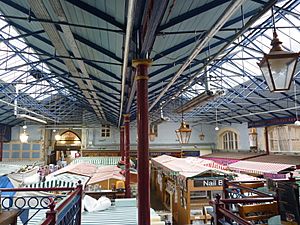Durham Indoor Market facts for kids
The Durham Indoor Market is a covered market found near the Market Place in the City of Durham, England. It's a busy place where people can buy all sorts of things.
Contents
A Look Back: The Market's History
The City of Durham has always been a place for markets, even way back in Saxon and Norman times. The Market Place was the main spot where traders sold their goods. Farmers, butchers, greengrocers, shoemakers, and even entertainers gathered there.
Where the Market Hall Stands
The land where the Market Hall is now used to be part of a grand estate called New Place. This was a palace and gardens built a long time ago for the Neville family. They were powerful lords, but they lost their property to the King after they were involved in a big rebellion in 1569.
Later, in 1612, King James II sold the palace to a group called Henry Smith's Charity. It was used as a factory, a workhouse, and even a charity school. Eventually, the old palace was taken down to make room for the Market Hall we see today.
Building the Market Hall
A famous expert named Nikolaus Pevsner described the Market Hall's inside. He said it mostly has a roof made of cast-iron, supported by cast-iron columns. The back of the building, facing Leazes Road, looks strong and simple. It has a big wall and plain windows under a row of pointed roofs.
By the early 1800s, the Market Place became very crowded. Traders were spread out and it was hard to find things. Business people and traders worked together. They asked for a special building to be built for the market. They also wanted the markets to be better organized.
In May 1851, a special law was passed called The Durham Markets Company Act. This law helped set up new markets in Durham. It also helped organize the markets and fairs in the city.
In the late 1800s, the Market Hall was used for more than just selling goods. Horse, sheep, and cattle fairs were held there regularly. Twice a year, people looking for work as servants would come to be hired. At first, the market was only open on Saturdays. Trading would finish at 11 PM when the Market Bell rang. You can still see an example of this bell hanging in the Balcony Bistro today.
The Market's Big Re-Opening in 1996
Over time, people wanted to buy quality products at good prices more often. So, the market started opening on more days. After a big renovation, the Market Hall opened for trading from Monday to Saturday in November 1996.
The refurbished Market Hall was officially opened on December 20, 1996. The person who opened it was Rt Hon Tony Blair MP. At that time, he was the Leader of the Opposition, a very important political role. This was 144 years after the Market Hall first opened its doors!
Today, the Indoor Market is home to over 50 different traders. They sell a huge variety of food, goods, and services. More than 2 million visitors come through its doors every year.
Cool Facts About Durham Indoor Market
- There's a giant painting of the City on an inner wall. Students from Durham University's Student Community Action group painted it in 2010.
- Since it reopened, many famous people have visited. These include important politicians like Sir Ming Campbell and Rt. Hon. Nick Clegg MP. The well-known writer Terry Deary has also visited. The market has also hosted live radio and TV shows.
- Durham Indoor Market helps organize the amazing annual City of Durham Christmas Festival. This is the busiest shopping weekend of the year in the city center.
- The Durham Markets Company runs the Indoor Market. They also manage a Saturday Outdoor Retail Market. Plus, they run the city's Continental Market twice a year in the Market Place. They also play a big part in organizing the Durham Christmas Festival and the Durham City Food Festival.
- In 2010, the market added more space on its mezzanine level. This gave retailers more room and made the café bistro bigger.
- In January 2011, Durham Indoor Market won an award! It was named "Best Private Market" by NABMA. This is the National Association of British Market Authorities, a group that supports markets.



